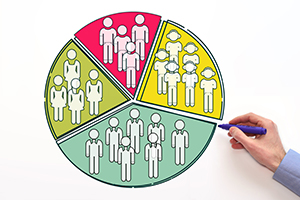Between paid search, display advertising, social media advertising, and video marketing, digital marketing offers many ways to get your message in front of your audience. Picking the right platform is the first step to getting great results from your marketing investment. The second is audience targeting.
Audience targeting is a simple, data-driven method that puts your ad in front of the right people more often. Here’s a closer look at what it is, why it works, and how to use it to improve your ad campaigns.

What Is Audience Targeting?
Audience targeting separates prospects and customers into groups based on their interests or demographics. It allows your business to deliver more personalized ads that speak directly to a specific audience.
When done well, audience targeting helps you get better results for each advertising dollar you spend. Instead of promoting to a large, general audience, you target prospects more likely to engage with your brand.
1. Start With Buyer Personas
Audience segmentation is a process that gets more effective with more data. As you test each theory you have about your audience and what they respond to, you get more data to improve results.
If you have been working with a professional digital marketing company like J&L or have an in-house team that tracks analytics, you can use your existing data to begin your segmentation. Otherwise, a great place to start is with your buyer personas.
A buyer persona is an avatar of your ideal or most frequent customer. For example, imagine your target audience for a new product is women between 30 to 45 who work full-time, love household products that save them time, and have disposable income. Instead of trying to create campaigns for the whole group, you would build a buyer persona that represents that type of woman.
In this example, imagine you found a photo of a 42-year-old professional woman. You call her Mary and fill in the buyer persona with details about her career, family, hobbies, pain points, and desires. Now, you have a clear picture of the segment you are creating marketing to reach.
2. Understand Key Audience Targeting Categories
As you continue to gather data on your audience segments, you can deliver highly relevant pay-per-click (PPC) ads or launch targeted direct mail or email marketing campaigns. To do this effectively, you must identify the most valuable ways to segment your audience.
The three most common ways to segment your audience are demographics, psychographics, and behavior.
Targeting by Demographics
Demographics include data such as age, income level, education level, gender, marital status, occupation, and race. Demographics are helpful but less specific than psychographics or behavior. For example, if you were marketing a high-performance sports car, you may target men between 35 and 60 who make at least $100,000 a year.
Not every man in that age and income range is interested in sports cars, but using those demographics helps you design your marketing to speak to those that are.
Targeting by Psychographics
Psychographics include a person’s values, interests, personality traits, affinities, and motivations. They can be harder to identify accurately but are more specific and targeted than demographics.
Ads for electric vehicles targeting people who show an active interest in environmental conservation are an example of psychographic targeting.
Targeting by Behavior
You can target customers based on actions they have taken on your website, in response to your emails, or based on items they’ve purchased in the past. For example, if someone spent an hour building a custom car online, you can email them about an upcoming sales event or show them ads highlighting financing options or critical features of the newest model.
Questions to Improve Audience Targeting
You’ll get the best results from audience targeting by regularly reviewing the data and refining your segments. Here are four questions to help you understand your audience segments and how to target them:
- Did this campaign reach our target audience?
- If not, who engaged with it?
- Did the audience respond in the way we wanted them to?
- What similar audience might also respond to these promotions or ads?
3. Understand Your Marketing Data
Marketing data is a treasure trove of useful information. It’s impossible to apply it all at once, but as you progress, you can use it to segment and expand your audience.
Using Google Analytics lets you identify different and possibly unexpected interests that your website visitors have. For example, you may be selling high-end appliances but discover that many of your customers enjoy fine wine. This creates an opportunity to expand your advertising to wine lovers who meet other key demographics. Perhaps you create display advertising for wine subscription sites, so people can see your ads while they select their wine.
This is an example of how you can use first-party data. However, there is also second-party and third-party data. Here is a quick look at each type and its strengths:
First-Party Data
First-party data includes all the data in your CRM, social platforms, and analytics software your company has compiled through your marketing and sales efforts. First-party data is ideal for audience targeting because it’s unique to your business, highly accurate, and already proven (for example, past customers who have already purchased from your company).
The limits to first-party data are that it’s a relatively small sample size and may not include all potential audience segments that can respond well to your brand.
Second-Party Data
If you sell appliances and know a property management firm with many clients who renovate and build properties, you may be able to market to their audience. This would be second-party data if they share their customer information and analytics with you.
Second-party data helps you reach a larger audience that another business has qualified. You may purchase the data or do an exchange that allows you each to market to the other’s customers.
Third-Party Data
Third-party data is broader and more general. It is collected and sold by data providers through public data exchanges.
While generally considered not as good quality as data you collect yourself, third-party data can help rapidly scale an advertising campaign. It can also help you find and reach new audience segments. However, do not use third-party data for email campaigns because it will lower your deliverability score.
4. Use Polls and Social Platforms
If you don’t have much data or are looking for other ways to learn about your audience, ask them! Polls and social media platforms are excellent ways to connect with your customers and discover what speaks to them.
Your social platforms can also be inexpensive ways to test out campaigns. If you have a display ad or a video marketing campaign, test it as a post on your Facebook, Instagram, or LinkedIn profile and see how your customers respond.
5. Don’t Assume: A/B Test!
Even if you know your customers well, you don’t want to assume you know what will appeal to them. Seasoned business owners and marketers are always surprised by what their audience responds to, which is why A/B testing your campaigns is essential.
A/B testing reduces risk. Sometimes a relatively small change to an ad, like the headline, the image, or the color, can dramatically improve your response rate. Many platforms like Facebook and Google allow you to A/B test variations at the start of your campaign.
6. Simplify Audience Targeting with Variations
Audience targeting can drive down ad spending while skyrocketing response rates, but it also means your marketing team needs to create, track, and monitor personalized ads for each audience segment. This adds a lot of time and effort to the process.
Modifying a single campaign for your different buyer personas is one way to simplify. You can personalize the headlines or content to speak directly to specific groups. For example, if you were marketing software used by small business owners and accountants, one ad might open with, “Business Owners! Save Time and Money With Acct,” while the second would read, “Accountants, Finally an Affordable Option Easy Enough for Any Client.”

7. Expand Your Reach With Lookalike Audiences
What demographics, psychographics, or behaviors do people who buy from you share? Lookalike audiences help you expand your reach with highly targeted advertising to people most likely interested in your brand.
You can build lookalike audiences based on people who responded to your advertising and followed through with a purchase or repeat customers. You can also use this data to refine any second-party or third-party data you use so you get the maximum impact from it with as little time and money wasted as possible.
8. Where to Use Audience Targeting
The beauty of marketing in the digital age is you can reach specific people where they are. You can craft tailored messages that engage prospects and customers when and where they will most likely respond. It is a process of education and refinement, but audience targeting is a powerful tool in your marketing arsenal.
Every search engine marketing (SEM) platform is set up for you to employ audience targeting. Paid search, discovery advertising, video marketing, and display marketing allow audience segmentation by demographics, psychographics, or behavior.
In some cases, with paid search advertising, you may want to allow the Google algorithm to test and narrow your audience for you. Too much segmentation on Google can result in higher ad costs and lower performance. Balance, tracking, and testing are the keys to success.
Audience Targeting Is Key to Digital Marketing Success
If you had an industrial pair of scissors, would you keep using the kids’ pair that barely cuts? No! Digital marketing brings the capacity to target audiences like never before, and it’s important to leverage it for marketing success.
At J&L Marketing, our team specializes in finding and developing the right market segments for your business. If you have questions about leveraging this remarkable tool to drive more leads and increase conversions, connect with us today.



